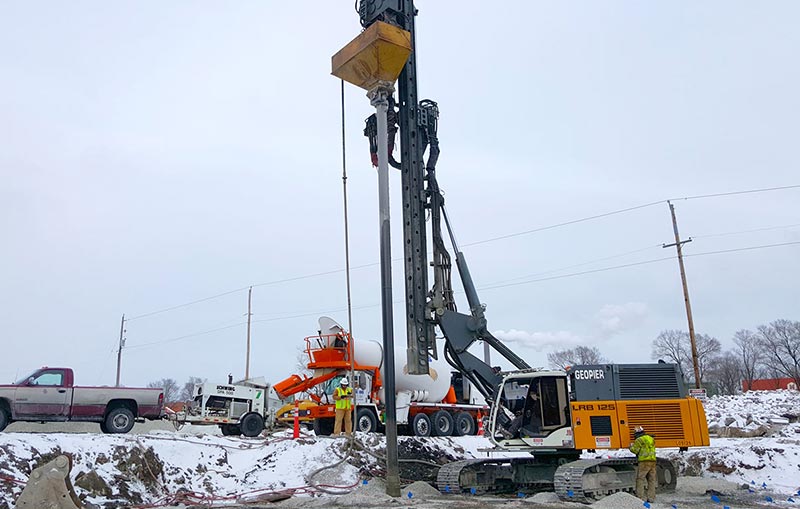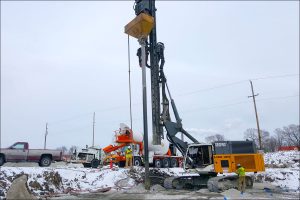Two-Story Retail Project With Rigid Inclusions Featured in Geo-Congress 2020 Conference Paper

 Steve Weyda, P.E. with Ground Improvement Engineering in Wisconsin, shares a rigid inclusion case history we contributed this year to a select Geo-Congress 2020 Conference Paper.
Steve Weyda, P.E. with Ground Improvement Engineering in Wisconsin, shares a rigid inclusion case history we contributed this year to a select Geo-Congress 2020 Conference Paper.
Ground Improvement Engineering was honored to contribute to a peer-reviewed conference paper selected to display at the national Geo-Congress 2020 in Minneapolis. I was invited as a co-author to write and submit the paper with three engineers from Geopier® Foundation Company, Inc.: Brian C. Metcalfe, P.E., Kord J. Wissmann, Ph.D, P.E. and Bruce Bush, G.I.T.
The paper provides three project case histories in which organic soils were reinforced by confined aggregate or cemented ground improvement elements. The paper makes the case for successful use of “intermediate” ground improvement, “even in conditions such as when the thickness of the organic soils is large, when the loads are heavy, or when the consequences of settlement are severe.”
The following is a modified excerpt of one case history included in the Geo-Congress paper. We were part of the team that implemented a ground improvement alternative to solve soil and foundation challenges for a two-story, mixed-use building in Fontana-On-Geneva Lake, Wis.
Rigid inclusion solution
“The generalized soil profile [at this site] consisted of 5 feet (1.5 meters) of loose to medium dense sand fill overlying 13 to 20 feet (4 to 6 meters) of very soft, organic silt and peat seams underlain by medium stiff to stiff clay to a depth of 50 feet (15 meters). Groundwater was encountered within the organic layers at depths of 8 to 10 feet (2.5 to 3 meters).
“It was recognized by the project geotechnical engineer that significant long-term settlements would occur for footings and slabs bearing on untreated subgrades. The grade raise fill would further compound the settlement issues. For this reason, the primary foundation option consisted of helical piers or driven piles and structurally supported slab.
“Ground improvement was proposed as a value engineering alternative to replace the deep foundation and structural slab option. Grouted aggregate piers (Geopier Grouted Impact® system) were selected for foundation support to provide cementitious elements that will convey the foundation loads through the organic soil and develop support and settlement control from the underlying very stiff soil deposits. Conventional displacement aggregate piers could then be utilized to support the grade raise fill and floor slab, including a 3-foot (1-meter) surcharge.”
What are grouted aggregate piers (Geopier Grouted Impact system)?
“Grouted aggregate piers are a type of “rigid inclusions” element that consists of constructing displacement aggregate piers with a neat cement slurry added to the aggregate mix during construction. The grouted aggregate pier is constructed using a hollow-pipe mandrel that has typical pipe diameters of 12 to 16 inches (300 to 400 mm). Open-graded aggregate, such as #57 stone, is added to the pipe mandrel by a top mounted hopper, and neat cement slurry is dosed into the mandrel to create a gravel and cement slurry mix. The mandrel and hopper are attached to a fixed leader mast and high frequency vibratory hammer mounted to a base excavator. The mandrel is driven to the design depth using the hydraulic crowd pressure and vertical vibratory action of the hammer as the gravel and grout mixture is added.
“The grouted aggregate piers were installed below the foundations to depths of 25 to 30 feet (7.5 to 9 meters) below grade penetrating into the very stiff clay and medium dense sand deposits. The grout was discontinued at depths of 1 to 2 feet (30 to 60 cm) below the bottom of footing elevation to provide uncemented aggregate pier elements through the sand fill to reduce the potential for “hard spots” below the foundations.
This example and two other case histories presented in the Geo-Congress 2020 paper demonstrate that rigid inclusions or confined aggregate piers with polymeric sleeves are being utilized more commonly for organic soil sites to reduce the risks of poor long-term performance in these soil types. They can be utilized to provide control of foundation settlement and can result in significant savings compared to traditional foundation support methods (helical or driven piles). They can also allow for use of normal spread footings and slab on grade.
